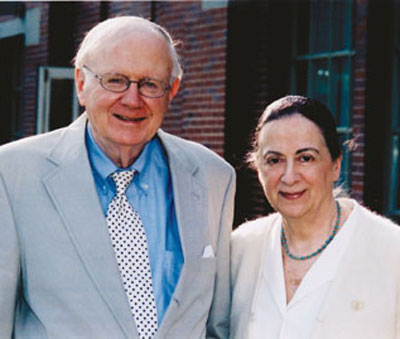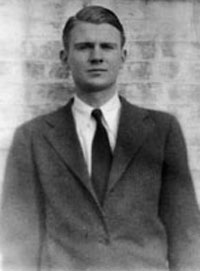|
|
 |
 |
 |
 |
|
FIRST PERSONColumbia in Transition: The Post-War EraBy Arthur L. Thomas ’50
My first impressions of Columbia College in September 1946 were of its awesome environs. Huge, forbidding buildings — at least, forbidding to me — characterized the campus. As a college student, I was one step closer to leaving the halls of academia and entering the workaday world. How-ever, the College (mainly Hamilton Hall) was unusual in the sense that it was surrounded by other University buildings, beckoning us to enter the various graduate and professional schools after college, an environment quite different from that of colleges with no university affiliations. I entered Columbia College in the first full post-war year. Students as well as instructors wore jackets and neckties — this was way before the era of blue jeans and T-shirts. Classes had many returning veterans taking advantage of the G.I. Bill of Rights. In the peak year of 1947, veterans represented 49 percent of college enrollment in the U.S., according to the Veterans Administration. The College, of course, was all-male, but Barnard was across the way and we did not feel that anything was missing by not being a co-ed student body. This was a time in which the University was not top-heavy with administration. Columbia was a “renaissance university” in the ancient sense. There was a story that at one time in the 1920s or 1930s, a chemistry professor who had been chosen to be department chairman went to the University president, Dr. Nicholas Murray Butler (Class of 1882) and asked him what he was to do in that function. Butler replied, “You know what to do.” I joined the renaissance, majoring in science and engineering, relishing these classes and the Contemporary Civilization and Humanities courses. They all required much effort in a competitive atmosphere; more than one student mentioned to me the tension under which he studied. I also studied engineering drafting and descriptive geometry in my freshman year, from which I still have the textbook, Engineering Drawing, by Thomas E. French. Inside the front cover, I noted, “Allen Vreeland, Ray Lyerly” who undoubtedly were the instructors. Also written inside the book was “2.70,” the going price for a textbook at that time; the going price for a subway ride was 10 cents. I was a CC student of Richard Hofstadter, who was on his way to winning the Pulitzer Prize in history, and a Humanities student of Vladimir Ussachevsky, who became a well-known music composer. I studied general chemistry under Charles O. Beckman in the grand Havemeyer lecture hall with a 40-foot domed ceiling and oak demonstration table. These were inspired people who spoke with intensity and fervor about their subjects. I still am amazed how they could speak before groups of students day after day, several hours a day, and never tire. The College also provided inspirational experiences outside the classroom. I had never heard of crew until I went to Columbia, but in September 1946, I saw a notice on a bulletin board calling for candidates. I responded, and crew became the gateway to many positive competition experiences on the Harlem and Hudson rivers and at venues in New England, New Jersey and Pennsylvania. In the fall and spring, it was a delight to go to the Gould boathouse at the northern tip of Manhattan and practice rowing in such sublime surroundings, far removed from the hustle and bustle of the city. It was a privilege to row for Columbia, and I look back on my days on the water as some of the great moments of my life.
I also enjoyed participating in the Van Am Society (the honorary service society) and the Delta Phi Fraternity, Delta Chapter, at 609 W. 114th St., known to some as the “crew fraternity,” founded at Columbia in 1842. I was a student at a time of transition, from the stable pre-war era in the first half of the 20th century to the beginning of the rapidly changing post-war era of the second half of the century. Butler passed away a year after I entered Columbia. Dr. Frank Diehl Fackenthal was acting University president from 1945–48. In 1948, General Dwight D. Eisenhower became University president, and my stay at the College was capped by receiving a diploma with Eisenhower’s signature. His son, John, studied at Columbia at this time and received a master of arts in English from GSAS in 1950. At the same time, my father was a professor at the University and president of the Men’s Faculty Club from 1948–50. I did not see or meet Eisenhower, but my parents always remembered their pleasant encounters with him and Mrs. Eisenhower. What better recommendation is there for Columbia than the fact that my father, Arthur W. Thomas ’12, earned additional degrees from Columbia in 1914 and 1915 and later served on the faculty; my sister, Madeleine, graduated from Barnard in 1947; and I graduated from Columbia College in February 1951. I have a friend who did not attend college but has enjoyed a successful career, and I asked him if it is worthwhile to go to college. He said, “It makes a difference.” President Lee C. Bollinger said it more eloquently: “Universities remain meaningful because they respond to the deepest of human needs, to the desire to understand and to explain that understanding to others. A spirited curiosity coupled with a caring about others is a simple and unquench-able human drive.” After graduating from Columbia College, Arthur L. Thomas ’50 attended the Engineering School and then Princeton Engineering. After earning his Ph.D. there in 1956, he entered the chemical industry, where he was engaged in research and development in New Jersey, West Virginia and California until 1968. He then taught college and spent a year in university research, later becoming science and engineering editor at Roland Press in Manhattan and market researcher at Hull & Co. in Greenwich, Conn., followed by freelance work in engineering information. Thomas is the author and co-author of several books and articles as well as the editor of and a contributor to Fred C. Hess’ book, Chemistry Made Simple. He married Charlotte, a nurse whom he met at Columbia, in 1977.
|
|
|||||||||||||||||||||||||||||||||||||||||||||||||||||||||||

